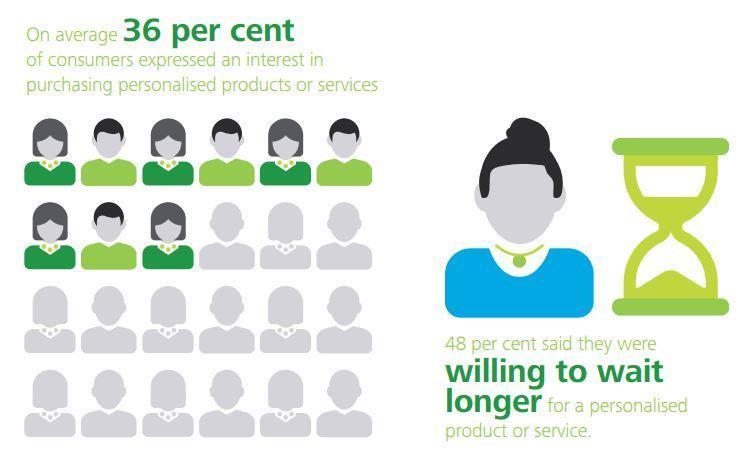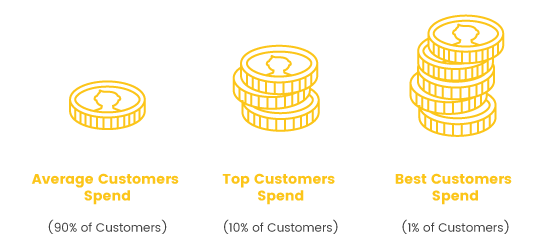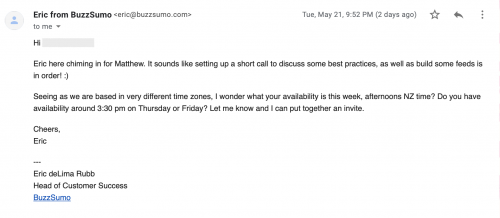Creating quality long-form content is no longer enough to boost conversions for your business.
You also need to make sure that it’s personalized. What that means is that it’s got to look, sound, and feel like you’ve created that content for your target lead or visitor.
The reason? Today’s customers not only prefer it: they expect it!
In a report published by eConsultancy, 57% of customers state that they would be willing to exchange their contact details for personalized offers. As many as 32% expected these to be sent to them within an hour from the time they submitted their details.
What’s more, a study published by Deloitte shows that 36% of customers are more willing to buy products and services they believed to be personalized to their needs.

To do that, you have to know which topics will resonate with them. At the same time, you’ve got to be able to strategically time when they receive your content for maximum impact.
That’s where content mapping comes in.
Content mapping is a carefully planned method of choosing which topics and types of content to be published within your marketing funnel. By feeding your leads with the right content at the right time, you’ll be able to build a relationship with them and encourage them to convert into customers. It should be part of any strategic marketing plan.
It may sound like a daunting task. But it isn’t if you know where to start. Here are four simple and effective steps to map your content to supercharge your marketing funnel.
1. Know who your ideal client is.
This is crucial if you’re running a B2B or B2C business. Your ideal client profile will guide your content and mapping strategy.
Now, you may think that this is something that most businesses have mastered, since it’s now become a requirement when you launch any marketing strategy, especially in your marketing funnel’s decision stage.
According to Grant Deken, Founder of Spark CMS, understanding how to make your prospective customers comfortable and secure with their purchase decisions is gold. It’s what can help you identify and create the right kind of content on different conversion points so that they take the action you want.
Yet, 65% of marketers and business owners still don’t get it.
The reason is very simple. When marketers and business owners create their buyer personas, they tend to do so based on what they think their customers would want to receive.
The problem with this is that they’re approaching the creation of their buyer persona through the eyes of a marketer, not a customer. As a result, there’s a disconnect between the content they publish at different stages of their marketing funnel and what their customers want and need to receive.
So how do you create a strong buyer persona that would give you a meaningful look into your customers’ thinking? You’ll need to ask them. Send out a survey or an invitation to interview to those that are already in your email list. Ask insightful, open-ended questions.
You can use a tool like Mention to check which of your competitors’ content is getting the most engagement from your shared target customers. Take notes and create similar content on your site.
2. Understand how your customers buy.
Timing is critical in content mapping. It’s the secret to what will personalize your content because you’re giving your leads the right content at just the right time. This, in turn, will make it easier for you to nudge them to take action and move further down through your buyer’s journey.
An excellent example of this is what Airbnb founders Brian Chesky and Joe Gebbia did when they were trying to come up with a marketing strategy. They asked themselves one simple question: where would their customers go if Airbnb didn’t exist?
What did they do? They became their potential customers. They kept in mind the websites and channels they visited to find places to stay. They also became mindful of their selection process.
They then took all of these and began applying this not just to their content mapping, but also on how they created their entire business. The rest is history.
3. Create the right content.
Think of content mapping like putting together a jigsaw puzzle. Sometimes, you find a piece that seems to fit in a particular spot. However, when you try to join the piece with the rest of the puzzle, it just doesn’t quite fit.
The same thing goes with your content. Even if your content rocks, if it’s not sent at the right time, it won’t give you the conversions you’re hoping for.
Before talking about what kind of content you should include within your marketing funnel, let’s take a step back and take a look at the marketing funnel overall.
A marketing funnel is made of four distinct stages: awareness, consideration, decision, and delight.
Awareness Stage
The awareness stage is when your prospective customers are trying to learn more about the problem they are facing so that they can properly address it.
As a marketer or a business owner, your goal here is to drive traffic, then educate them and give them quick solutions that they can apply immediately.
At the same time, this is when you introduce yourself and your business as a reliable resource that they can turn to help them solve their problem. This is crucial because you have to get them to trust you first. Studies show that your prospective customers would prefer doing business with someone that they trust and have already built a relationship with.
The most effective kinds of content in this stage are:
- Educational blog posts
- Infographics
- Social media posts
- Checklists
- Guides
- Podcasts
Consideration Stage
In the consideration stage, your prospective customers went through different solutions to help address their problem (including yours). Now, they’re beginning to shortlist their options.
When it comes to content mapping, your goal here should nurture them by giving them content that specifically targets their needs. This is also the stage in your marketing funnel where you start to introduce how your products and services can help them address not only their problem, but also reach their set goals.
Explainer videos, like the one I created below on how to create web pages on Spark CMS, are an example of content for your consideration stage.
Decision Stage
Those leads that have gone this far down into your marketing funnel are now choosing which company to buy from. Your job now is to close the lead.
This stage in your marketing funnel is what I’d like to refer to as the “deal maker or breaker” stage as far as content mapping goes. Here, you have to convince them to buy from you, not your competitors.
Case studies like this one from Loganix work great in the decision stage.

Delight Stage
At this stage, your leads have converted into paying customers. Now, the content mapping challenge for you here is to keep them happy and make them repeat buyers, or even advocates of your brand.
This helps you boost your marketing funnel’s conversions in three ways. First, it’s cheaper to keep your existing customers happy. Harvard Business Review’s study shows that acquiring new customers is 25x more expensive than retaining existing customers.
Second, happy customers spend more on their next purchase on your site. One study shows that a returning customer or client will pay up to 5x more than a first-timer.

Also, clients that are happy and satisfied with your products or services, they won’t hesitate to recommend you to those in their network. Moreover, since customers are more willing to buy from a product or service recommended by someone they know, these new customers will go ahead and make a purchase, shortening the entire buying process.
The best kinds of content at this stage of your marketing funnel are those that focus on helping your existing customers get the most of their experience with your business.
Buzzsumo does an excellent job at this. To ensure that their existing clients are getting the most of their service, they include a video call as part of their onboarding process.

This way, they help their new clients properly use the tools available so that they get the results their customers are expecting from using their services.
4. Invest in the right content marketing tools.
Good news: there are lots of marketing tools available to use for your business.
The bad news? Choosing the right tools to include in your marketing stack can be a pain, especially when it comes to finding tools that your sales and marketing teams will use. That’s because the majority of these tools don’t “talk” to each other very well. When that happens, it can cause a misalignment between your sales and marketing teams.
So it’s not enough that you choose tools that will help you get specific tasks done, but also make sure that these tools integrate seamlessly with each other. That way, you and your team can monitor the progress of your content mapping efforts, and adjust areas where issues may arise.
EffinAmazing’s Founder and CMO, Dan McGaw, created an excellent Marketing Technology Stack guide where he shares not only the tools they use for their content marketing but also how he got them to work together sans the hassle and frustration. Be sure to check that out.
In closing…
Content mapping is an effective way to personalize the content you use to nurture your leads by sending the right content at the right time. Following the steps shared here will boost your conversion rate, and begin to start getting more leads and customers for your business.

About the Author:
Kevin Payne is a content marketing consultant who helps software companies build marketing funnels and implement content marketing campaigns to increase their inbound leads.


